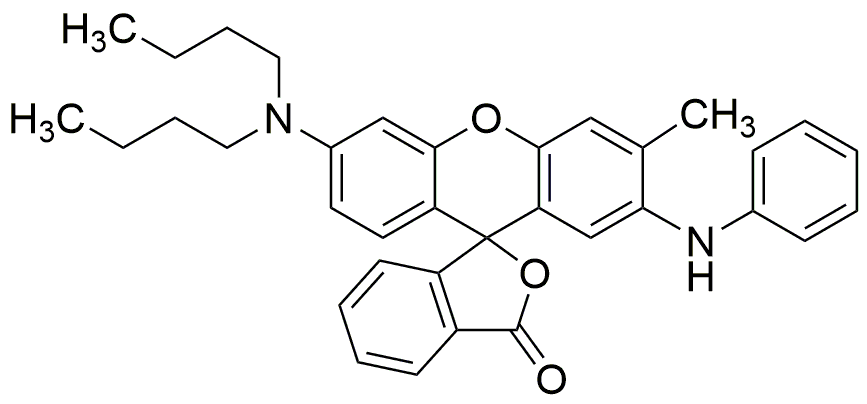2'-Anilino-6'-(dibutylamino)-3'-methylfluoran is widely utilized in research focused on:
- Fluorescent Dyes: This compound serves as a vibrant fluorescent dye in biological imaging, allowing researchers to visualize cellular structures and processes with high clarity.
- Sensor Development: It is employed in the creation of chemical sensors due to its sensitivity to environmental changes, making it useful for detecting pollutants or toxins in various settings.
- Photodynamic Therapy: In the medical field, this chemical is explored for its potential in photodynamic therapy, where it can selectively target and destroy cancer cells when activated by light.
- Polymer Chemistry: It is used in the formulation of specialty polymers that require specific optical properties, enhancing the performance of materials in applications such as coatings and electronics.
- Research in Organic Electronics: The compound is investigated for its role in organic light-emitting diodes (OLEDs), contributing to advancements in display technologies with improved efficiency and color quality.
General Information
Properties
Safety and Regulations
Applications
2'-Anilino-6'-(dibutylamino)-3'-methylfluoran is widely utilized in research focused on:
- Fluorescent Dyes: This compound serves as a vibrant fluorescent dye in biological imaging, allowing researchers to visualize cellular structures and processes with high clarity.
- Sensor Development: It is employed in the creation of chemical sensors due to its sensitivity to environmental changes, making it useful for detecting pollutants or toxins in various settings.
- Photodynamic Therapy: In the medical field, this chemical is explored for its potential in photodynamic therapy, where it can selectively target and destroy cancer cells when activated by light.
- Polymer Chemistry: It is used in the formulation of specialty polymers that require specific optical properties, enhancing the performance of materials in applications such as coatings and electronics.
- Research in Organic Electronics: The compound is investigated for its role in organic light-emitting diodes (OLEDs), contributing to advancements in display technologies with improved efficiency and color quality.
Documents
Safety Data Sheets (SDS)
The SDS provides comprehensive safety information on handling, storage, and disposal of the product.
Product Specification (PS)
The PS provides a comprehensive breakdown of the product’s properties, including chemical composition, physical state, purity, and storage requirements. It also details acceptable quality ranges and the product's intended applications.
Certificates of Analysis (COA)
Search for Certificates of Analysis (COA) by entering the products Lot Number. Lot and Batch Numbers can be found on a product’s label following the words ‘Lot’ or ‘Batch’.
Número de catálogo
Número de lote/lote
Certificates Of Origin (COO)
This COO confirms the country where the product was manufactured, and also details the materials and components used in it and whether it is derived from natural, synthetic, or other specific sources. This certificate may be required for customs, trade, and regulatory compliance.
Número de catálogo
Número de lote/lote
Safety Data Sheets (SDS)
The SDS provides comprehensive safety information on handling, storage, and disposal of the product.
DownloadProduct Specification (PS)
The PS provides a comprehensive breakdown of the product’s properties, including chemical composition, physical state, purity, and storage requirements. It also details acceptable quality ranges and the product's intended applications.
DownloadCertificates of Analysis (COA)
Search for Certificates of Analysis (COA) by entering the products Lot Number. Lot and Batch Numbers can be found on a product’s label following the words ‘Lot’ or ‘Batch’.
Número de catálogo
Número de lote/lote
Certificates Of Origin (COO)
This COO confirms the country where the product was manufactured, and also details the materials and components used in it and whether it is derived from natural, synthetic, or other specific sources. This certificate may be required for customs, trade, and regulatory compliance.


